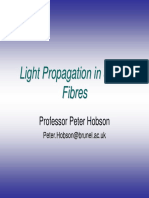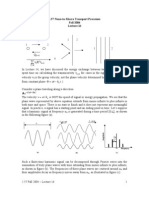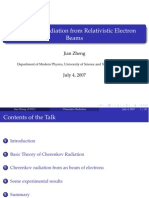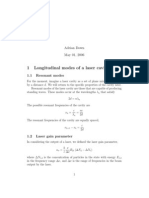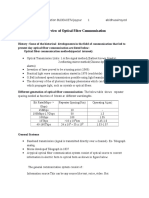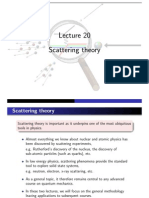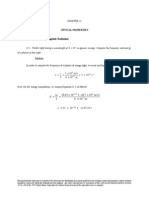Optical Fibre
Optical Fibre
Uploaded by
Abdul Qadir Mohamed AbdiCopyright:
Available Formats
Optical Fibre
Optical Fibre
Uploaded by
Abdul Qadir Mohamed AbdiOriginal Description:
Original Title
Copyright
Available Formats
Share this document
Did you find this document useful?
Is this content inappropriate?
Copyright:
Available Formats
Optical Fibre
Optical Fibre
Uploaded by
Abdul Qadir Mohamed AbdiCopyright:
Available Formats
1
Optical fibres are one of the most important components in an optical fibre system
because its transmission characteristics play an important role in the performance of the
entire system.
Some important questions on optical fibre:
What is the structure of an optical fibre?
How does light propagate along the fibre?
What materials are fibres made of?
How is it fabricated?
What is the signal loss or attenuation mechanism in a fibre?
Optical Fibre Waveguide Optical Fibre Waveguide
2
How does light propagate along a fibre?
Basically, the involved theory can be divided into two types as follows:
Ray theory transmission
Wave theory transmission
Refractive index n is the the ratio of the speed of light, c in vacuum to that in the
material, v.
n = c / v
Upon entering a material, the speed of light would reduce, and it depends on the type of
material.
The concept of reflection and refraction can be understood by considering the behaviour
of light rays travelling in a dielectric material.
When light ray encounters a boundary separating two different media, a part of the ray is
reflected back ( if n
1
> n
2
) and the remainder will bend (refracted) as it enters the second
medium.
Optical Fibre Waveguide
n
air
= 1.00, n
water
= 1.33
n
glass
= 1.50, n
diamond
= 2.42
3
Snells law states the relationship between the refractive indices of materials, and the
angles of incidence and refraction as:
n
1
sin
1
= n
2
sin
2
, where n
1
and n
2
are the refractive indices of different materials, while
1
and
2
are the
angles of incidence and refraction, respectively.
Ray Theory Transmission
Snells Law:
Medium 2
Medium 1
Normal
2
High index n
1
(glass)
Incident ray
Partial internal
reflection
Exit ray
Low index n
2
(air)
2
Optical Fibre Waveguide
4
Critical Angle
As n
1
> n
2
, the angle of refraction is always greater than the angle of incidence.
When the angle of refraction
2
is 90
o
(parallel to the interface), the incidence angle is
called the critical angle
c
.
sin
c
= n
2
/ n
1
Total Internal Reflection
At the angles of incidence greater than the critical angle, light is reflected back into the
originating dielectric medium.
Total internal reflection occurs when:
n
1
> n
2
.
angle of incidence exceeds the critical angle.
This is the basic mechanism by which light can propagate down an optical fibre.
1
2
Optical Fibre Waveguide
5
Transmission of a light ray in a perfect optical fibre:
Optical Fibre Waveguide
6
Acceptance Angle
We have considered the propagation of light in an optical fibre.
What is the amount of light which can enter the optical fibre?
Since only rays with a sufficiently shallow grazing angle at the interface is transmitted,
it is clear that not all the rays entering the fibre core will continue to propagate down the
fibre.
Optical Fibre Waveguide
7
Numerical Aperture
The relationship between the acceptance angle and the refractive indices of the media
leads to the definition of numerical aperture NA, which is given as:
NA = n
o
sin
a
= (n
1
2
n
2
2
)
1/2
It should be noted that rays over the range of 0 <
1
<
a
will be propagated within the
fibre.
The NA can also be written in terms of the relative refractive index as:
NA = n
1
(2)
1/2
, where = (n
1
2
n
2
2
)/ 2n
1
2
(core-cladding index difference/=0.01)
or (n
1
n
2
)/n
1
for n
1
> n
2
.
NA: 0.14 0.50
Optical Fibre Waveguide
for commercial use
NA=0.3
Waveguide Theory
In the previous section, we have discussed the propagation of light in terms of ray theory.
In order to obtain a more detail model for the EM wave propagation, electromagnetic
wave theory must be considered.
The basis is provided by Maxwells equations:
t
B
E
=
r
r r
0 = D
r r
0 = B
r r
D = E and B = H
E
t
E
H +
=
r r
(1)
(2)
(3)
(4)
, where : permittivity or dielectric constant
: permeability
Optical Fibre Waveguide
Substituting for D and B and taking the curl of eqs. (1) and (2)
( )
2
2
t
E
E
=
r
r
( )
2
2
t
H
H
=
r
r
These lead to the nondispersive wave equations in a nonconducting medium:
1
=
p
v is the phase velocity in the medium. where
( ) ( ) E E E
2
=
(Using vector identity: )
2
2
2 2
2
2
1
t
E
v t
E
E
p
=
v v
r
2
2
2 2
2
2
1
t
H
v t
H
H
p
=
r r
r
Wave
equations
Optical Fibre Waveguide
If E and H are varying sinusoidally with time at the frequency of light, then E and H can
be written as
E = E
x
exp (jt) a
x
and H = H
y
exp(jt) a
y
, then from eqs. (1) and (2)
Differentiating eq. (5) with respect to z and substituting from eq. (6), we get
(5)
(6) H j
z
E
=
E E j
z
H
+ =
E j E
z
E
+ =
2
2
2
H j H
z
H
+ =
2
2
2
Optical Fibre Waveguide
Let
2
=
2
+j, the solution of these equations are:
E = E
xo
exp(jt) exp(z)
H = H
yo
exp(jt) exp(z)
Writing = + j, being the attenuation coefficient and the phase constant, the
electric and magnetic fields are given by
E =E
xo
cos(tz) exp(z)
H = H
yo
cos(tz) exp(z)
These equations describe a TEM wave travelling in the positive z-direction undergoing
attenuation exp(z).
Useful expression: exp(jt) = cos(t) + j sin(t)
Optical Fibre Waveguide
Rewriting the propagation constant as :
= + j and
2
=
2
+ j
Equating the real and imaginary parts:
2
2
=
2
and 2 =
As glass is an insulator, the conductivity is very low, and the relative permeability is
approximately unity. Therefore, = 0 and
r
= 1.
In this situation, we get = 0 and = (). So, the fields are given by
E = E
xo
cos(tz) and H = H
yo
cos(tz)
Optical Fibre Waveguide
Cartesian and cylindrical polar coordinates of the wave equations hold for each
component of the field vector, every component satisfying the scalar wave equation.
represents a component of the E or H field.
For a scalar wave equation: ,
the solution is given by
, where k is the propagation vector or wave number.
It carries the information about the direction of propagation, and the rate of change of
phase with distance.
The magnitude of k is
2
2
2
2
1
t v
p
r
( ) r k t j
r
r
= exp
0
2
= k
Optical Fibre Waveguide
Phase velocity:
At a given time, say at t = 0 and z = 0, the amplitude of the wave is zero.
After t
1
sec, i.e. at t = t
1
the amplitude of the wave is still zero but it has traveled a
distance z
1
. Thus,
sin(t
1
z
1
) = 0 i.e t
1
z
1
= 0, which gives t
1
= z
1
The velocity of propagation is given by z
1
/t
1
= /, which is called phase velocity v
p
.
Thus, the phase velocity is the velocity of propagation of a point of constant phase in the
wave.
v
p
= / = /() = 1/()
If the dielectric medium is free space, then v
p
is the velocity of light c = 310
8
m/s.
For a dielectric of relative permitivity
r
, the phase velocity is given by
v
p
= 1/(
0
r
)= c /
r
= c/n
, where n =
r
is the refractive index of the dielectric medium.
Optical Fibre Waveguide
If
0
is the wavelength in the free space, the wavelength in the dielectric material is
given by
= 2/ = 2v
p
/ = 2c/n = c/nv =
0
/n
Thus, we get an alternative definition of given by
= 2/ = 2n/
0
= nk
, where k = 2/
0
is the propagation constant in the free space.
Optical Fibre Waveguide
Group velocity:
In practice, the light do not travel with only one wavelength, but instead, a combination of
wavelengths.
The light is generally composed of a group of plane wave components resulting in a
packet of waves.
This wave packet do not travel at the phase velocity of individual waves, but propagate
with a group velocity v
g
.
1/v
g
= d/d = (d/d)( d/d)
From above = 2/ = 2v
p
/ = 2c/n , so that d/d = 2c/n
2
= /
d/d = /, and d/d = d/d{2n
1
/) = 2n
1
/
2
+ 2/ dn
1
/d
Therefore, v
g
is given by v
g
= (d/d)/(d/d) = c/[n
1
(dn
1
/d)] = c/N
g
, where N
g
is called the group refractive index or group index of the fibre.
Optical Fibre Waveguide
The real velocity of the EM wave
Power flow in a dielectric medium
If we take the cross product of E and H, we get a third vector acting in the
direction of propagation with the units of watt/m
2
which is the power flow
per unit area. This vector is known as Poynting vector S given by
S = E H
The average power is given by S
av
= Re [(1/2) E H
*
]
The power in the core is calculated by
The power in the clad is calculated by
The relative core and cladding powers for a particular mode is given by
=
a
x y y x core
dr d H E H E r P
0
2
0
) (
2
1
=
0
2
0
) (
2
1
dr d H E H E r P
x y y x clad
(
|
|
.
|
\
|
=
+
) ( ) (
) (
1 1
1 1
2
2
2
ua J ua J
ua J
V
u
P
P
core
Optical Fibre Waveguide
<--- Treated as a loss
Over the whole cladding layer.
Planar waveguide
Combination of ray theory and wave theory (EM theory)
( ) r k t j E E
u
u
r
r
= exp
0
The propagation constants k
1
and k
2
are vectors, which can be decomposed into its x and
z axis to give
q = (n
1
2
k
o
2
2
)
1/2
p = (
2
n
2
2
k
o
2
)
1/2
, where p and q are propagation constants in x-direction, while is the propagation
constant in the z-direction.
d/2
x = 0
z
x
k
1
k
2
q
Optical Fibre Waveguide
NOT INCLUDED IN SYLLBUS
When the critical angle exceeds in the slab, p becomes imaginary, and can be expressed
in terms of a real attenuation
p = j
2
when this equation is used with the wave equation and the boundary condition, the
solution obtained would be:
( )
( )
|
.
|
\
|
|
.
|
\
|
=
2
exp
2
exp
2
cos
2
exp cos
) , (
d
x for z j
d
x p
qd
d
x for z j qx
E z x E
o y
The solution gives is the lowest order electric field TE
0
.
Optical Fibre Waveguide
You might also like
- Optical Waveguide TheoryDocument17 pagesOptical Waveguide Theory23213mNo ratings yet
- De-Broglie HypothesisDocument19 pagesDe-Broglie HypothesisAmanda BoltonNo ratings yet
- Electricity and Magnetism II - Jackson Homework 3Document4 pagesElectricity and Magnetism II - Jackson Homework 3Alejandro Espinosa100% (1)
- 2.57 Nano-to-Macro Transport Processes Fall 2004Document9 pages2.57 Nano-to-Macro Transport Processes Fall 2004captainhassNo ratings yet
- Emission and Absorption of Light Shape of The Emission BandDocument17 pagesEmission and Absorption of Light Shape of The Emission BandSemakalu AntonioNo ratings yet
- Lecture 12Document14 pagesLecture 12JayeshAtreyaNo ratings yet
- PB Sheet 4 and Solutions LMODocument6 pagesPB Sheet 4 and Solutions LMOShootingStarPhotonsNo ratings yet
- Light Propagation in Optical FibresDocument31 pagesLight Propagation in Optical FibresWail HamedNo ratings yet
- Quantum Photonics: Optoelectronics and Photonics: Wave Nature of LightDocument31 pagesQuantum Photonics: Optoelectronics and Photonics: Wave Nature of Lightgafeer fableNo ratings yet
- Formulas Optica Ondulatoria (By Carrascal)Document9 pagesFormulas Optica Ondulatoria (By Carrascal)Iñaki0% (1)
- Determination of Wave Length of Laser Radiation by Interference. Jung MethodDocument12 pagesDetermination of Wave Length of Laser Radiation by Interference. Jung MethodMəhəmmədəliNo ratings yet
- DR TMMP (Quantum)Document50 pagesDR TMMP (Quantum)Tmmp SmileNo ratings yet
- Making Sense of The Equation Sheet Interference & DiffractionDocument6 pagesMaking Sense of The Equation Sheet Interference & DiffractionAkash KapoorNo ratings yet
- Rosenzweig 1998 0154Document19 pagesRosenzweig 1998 0154Particle Beam Physics LabNo ratings yet
- PHYS1131 Solutions Tut 6 11Document14 pagesPHYS1131 Solutions Tut 6 11Jason Tan100% (2)
- 2.57 Nano-to-Macro Transport Processes Fall 2004: I T KXDocument8 pages2.57 Nano-to-Macro Transport Processes Fall 2004: I T KXcaptainhassNo ratings yet
- Cherenkov Radiation From Relativistic Electron Beams: Jian ZhengDocument28 pagesCherenkov Radiation From Relativistic Electron Beams: Jian ZhengGaetano SalinaNo ratings yet
- Combine PDFDocument99 pagesCombine PDFdilnasgsjwisnjNo ratings yet
- 1 Longitudinal Modes of A Laser Cavity: Adrian Down May 01, 2006Document7 pages1 Longitudinal Modes of A Laser Cavity: Adrian Down May 01, 2006Joshua WhitneyNo ratings yet
- II Polarization 2012Document12 pagesII Polarization 2012realzzz1No ratings yet
- Optical Waveguides Write-UpDocument7 pagesOptical Waveguides Write-UpgowdamandaviNo ratings yet
- Modern and Nonlinear OpticsDocument181 pagesModern and Nonlinear Opticssoma_venuNo ratings yet
- OPTICAL FIBER COMMUNICATION Basic and CharactersticsDocument36 pagesOPTICAL FIBER COMMUNICATION Basic and CharactersticsabidNo ratings yet
- 1 Interference of Two Optical FieldsDocument4 pages1 Interference of Two Optical FieldsprakhargodaraNo ratings yet
- PHYS 5583 (E & M Ii) Home Work #13Document3 pagesPHYS 5583 (E & M Ii) Home Work #13William HammerNo ratings yet
- Electromagnetic Wave Propagation Lecture 12: Oblique Incidence IDocument46 pagesElectromagnetic Wave Propagation Lecture 12: Oblique Incidence Ideepak2711988No ratings yet
- Quiz 3: 1 2 CritDocument1 pageQuiz 3: 1 2 Critcab0oseNo ratings yet
- Lecture 2 Electronic Structure of AtomsDocument72 pagesLecture 2 Electronic Structure of AtomsKEMPNo ratings yet
- He Soliton Transmissions in Optical Fibers: Keywords 2. Mathematical Modeling of The Solitary WaveDocument4 pagesHe Soliton Transmissions in Optical Fibers: Keywords 2. Mathematical Modeling of The Solitary Wavetau_tauNo ratings yet
- 2023 Fall Optics (I) Homework #2, Due 10/26: 0 R I R 0 I 0 - 1Document1 page2023 Fall Optics (I) Homework #2, Due 10/26: 0 R I R 0 I 0 - 1藍博懷No ratings yet
- CH 7Document60 pagesCH 7Paul ArcillaNo ratings yet
- 2.57 Nano-to-Macro Transport Processes Fall 2004: Ae Be CeDocument7 pages2.57 Nano-to-Macro Transport Processes Fall 2004: Ae Be CecaptainhassNo ratings yet
- Malik2012 PDFDocument6 pagesMalik2012 PDFManendra ChaudhryNo ratings yet
- Optical Fibers WaveGuidingDocument52 pagesOptical Fibers WaveGuidingMd ShadabNo ratings yet
- Lightpulsemitrec24 NotesDocument6 pagesLightpulsemitrec24 NoteswongkiyuuNo ratings yet
- Waves in Media: Ashcroft and Mermin, Solid State Physics (Saunders College, 1976, Page 553)Document42 pagesWaves in Media: Ashcroft and Mermin, Solid State Physics (Saunders College, 1976, Page 553)Amina lbrahimNo ratings yet
- Lec20-21 - Compressed SCATTER PDFDocument54 pagesLec20-21 - Compressed SCATTER PDFBobby WardNo ratings yet
- Lecture 1 - Quantum & Atomic StructureDocument41 pagesLecture 1 - Quantum & Atomic Structurejasumin91No ratings yet
- Introduction To Light: Chapter 1, Light Propagation in MediaDocument58 pagesIntroduction To Light: Chapter 1, Light Propagation in MediaLee Kar HuoNo ratings yet
- M4 - Wave Propagation Polarization _F2024Document6 pagesM4 - Wave Propagation Polarization _F2024rizkomar6No ratings yet
- Section 13 Optical Properties of SolidsDocument9 pagesSection 13 Optical Properties of SolidsFatma AbdallahNo ratings yet
- Classical Optics 2Document6 pagesClassical Optics 2JuanRafaelÁlvarezNo ratings yet
- Homework 12 For Optics-part2-AnswersDocument8 pagesHomework 12 For Optics-part2-Answers子森 戴No ratings yet
- P2214 Homework 14 Solutions - Spring 2011Document7 pagesP2214 Homework 14 Solutions - Spring 2011calcyeeNo ratings yet
- M-3 OfcDocument15 pagesM-3 OfcRohan. M. NagaliNo ratings yet
- Plasmonics SelectedTopicsDocument52 pagesPlasmonics SelectedTopicsDominic LeeNo ratings yet
- InterferenceDocument38 pagesInterferenceAbror md FayiazNo ratings yet
- Lecture 1, Part 1Document38 pagesLecture 1, Part 1khaireshubhamaNo ratings yet
- Lecture 3 Student ENE423Document14 pagesLecture 3 Student ENE423reraisinNo ratings yet
- ch7Document43 pagesch7Shella TanNo ratings yet
- CHAPTER 7 & 8 - OpticsDocument18 pagesCHAPTER 7 & 8 - Opticssamiislamemon619No ratings yet
- PHY 303L MT4 SolutionsDocument9 pagesPHY 303L MT4 SolutionsbrunosipodNo ratings yet
- Lect10 PDFDocument8 pagesLect10 PDFDicia KesumaNo ratings yet
- 17 InterferometersDocument84 pages17 InterferometersAnirban PaulNo ratings yet
- Be - First Year Engineering - Semester 2 - 2018 - December - Applied Physics II CbcgsDocument20 pagesBe - First Year Engineering - Semester 2 - 2018 - December - Applied Physics II Cbcgsmahek guptaNo ratings yet
- 4.1-Derivation of The NLSEDocument14 pages4.1-Derivation of The NLSESathiyan100% (1)
- X-Rays Some Basics (Optional Reading)Document7 pagesX-Rays Some Basics (Optional Reading)Sandy emulatorNo ratings yet
- Feynman Lectures Simplified 2C: Electromagnetism: in Relativity & in Dense MatterFrom EverandFeynman Lectures Simplified 2C: Electromagnetism: in Relativity & in Dense MatterNo ratings yet
- Green's Function Estimates for Lattice Schrödinger Operators and ApplicationsFrom EverandGreen's Function Estimates for Lattice Schrödinger Operators and ApplicationsNo ratings yet
- Chapter - 10: Light: Reflection and RefractionDocument42 pagesChapter - 10: Light: Reflection and RefractionGarvit Khare75% (4)
- Space Wave Propagation: 16011A0458 Tejasri Kurapati JntuhDocument33 pagesSpace Wave Propagation: 16011A0458 Tejasri Kurapati JntuhKurapati tejuNo ratings yet
- PHSC2112 Q2 Written Work 1Document6 pagesPHSC2112 Q2 Written Work 1RussianOmeleteNo ratings yet
- CH 21Document32 pagesCH 21Indro ParmaNo ratings yet
- SSC-PS Book-2023Document55 pagesSSC-PS Book-2023Kgmghs Chirala100% (1)
- MCQs On Refraction of Light at Plane SurfacesDocument11 pagesMCQs On Refraction of Light at Plane SurfacesDigant Donthy100% (1)
- CST-05 With Solution (1st April) PDFDocument30 pagesCST-05 With Solution (1st April) PDFkavyareddyNo ratings yet
- Problems and Solutions On Optics - Bai Gui-Ru, Guo Guang-Can, Lim Yung-Kuo - 1st EditionDocument204 pagesProblems and Solutions On Optics - Bai Gui-Ru, Guo Guang-Can, Lim Yung-Kuo - 1st EditionquarkqNo ratings yet
- G12 Physics Pre Board - 1 QP With SolutionsDocument25 pagesG12 Physics Pre Board - 1 QP With SolutionsSreshta ReddyNo ratings yet
- Cambridge IGCSE (9-1) : Physics 0972/21Document16 pagesCambridge IGCSE (9-1) : Physics 0972/21Tristan GrahamNo ratings yet
- Basic Science (22102) Question BankDocument4 pagesBasic Science (22102) Question BankSatish Edake100% (1)
- New Characterization Method For Macrostructures of Ceramics Hybrid MaterialDocument4 pagesNew Characterization Method For Macrostructures of Ceramics Hybrid MaterialMohammed Al-MutawaNo ratings yet
- Basic PhysicsDocument106 pagesBasic PhysicsHerbert Nyaruwata100% (1)
- Sample Paper 01 - Class 12th NEET 2024 - Physics - Vijay Gupta - Questions 4Document6 pagesSample Paper 01 - Class 12th NEET 2024 - Physics - Vijay Gupta - Questions 4asifmd9963No ratings yet
- Polarization Independent, Tunable Waveguide Bragg Gratings in Lithium Niobate by Femtosecond Laser MicromachiningDocument2 pagesPolarization Independent, Tunable Waveguide Bragg Gratings in Lithium Niobate by Femtosecond Laser MicromachiningjohnNo ratings yet
- Fibre optics NotesDocument10 pagesFibre optics Notessamyakkadam055No ratings yet
- 1.each of The Solids Shown in The Diagram Has The Same MassDocument12 pages1.each of The Solids Shown in The Diagram Has The Same MassrehanNo ratings yet
- Chapter 22 - Reflection and Refraction of LightDocument45 pagesChapter 22 - Reflection and Refraction of Light2022495898No ratings yet
- Ii Puc - Physics: Chapterwise Questions From Board Exam Papers - March 2014 - May 2022Document19 pagesIi Puc - Physics: Chapterwise Questions From Board Exam Papers - March 2014 - May 2022Tejaswini S.kNo ratings yet
- Ray Optics and Optical InstrumentsDocument6 pagesRay Optics and Optical InstrumentsJasdeep SinghNo ratings yet
- Physics SyallabusDocument18 pagesPhysics Syallabustysonthor44No ratings yet
- Unit 6: Electromagnetic Wave and Geometrical OpticsDocument93 pagesUnit 6: Electromagnetic Wave and Geometrical Opticskidanemariam HabtemariamNo ratings yet
- Melc-Matrix-General Physics 2Document6 pagesMelc-Matrix-General Physics 2Ronald ValenzuelaNo ratings yet
- Interferometer: Instruction Manual and Experiment Guide For The PASCO Scientific Model OS-8501Document18 pagesInterferometer: Instruction Manual and Experiment Guide For The PASCO Scientific Model OS-8501Mauricio RaúlNo ratings yet
- Along Light: A Slab Is A Piece of Transparent RectangularDocument3 pagesAlong Light: A Slab Is A Piece of Transparent RectangularParam BalodiyaNo ratings yet
- Classification of Optical FibresDocument4 pagesClassification of Optical FibresManjesh KumarNo ratings yet
- Unit Test 2Document7 pagesUnit Test 2Vinayak BhatNo ratings yet
- Exp. 1Document10 pagesExp. 1Rajat PandaNo ratings yet
- Dispersion RelationsDocument133 pagesDispersion RelationsMichelle HoltNo ratings yet
- Module 5 Colors of LightDocument25 pagesModule 5 Colors of LightRochelle Mae G. IrincoNo ratings yet







